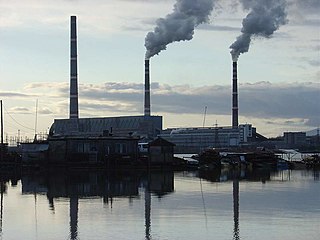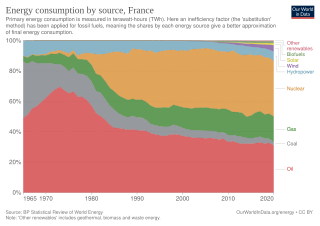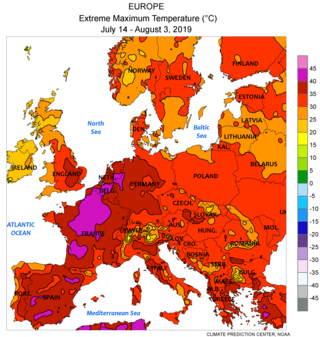The European Climate Change Programme (ECCP) was launched in June 2000 by the European Union's European Commission, with the purpose of avoiding dangerous climate change.
The goal of the ECCP is to identify, develop and implement all the necessary elements of an EU strategy to implement the Kyoto Protocol. All EU countries' ratifications of the Kyoto Protocol were deposited simultaneously on 31 May 2002. The ECCP involved all the relevant stakeholders working together, including representatives from Commission's different departments, the member states, industry and environmental groups. [1]
The European Union Emissions Trading System for greenhouse gases (EU ETS) is perhaps the most significant contribution of the ECCP, and the EU ETS is the largest greenhouse gas emissions trading scheme in the world.
In 1996 the EU adopted a target of a maximum 2 °C rise in global mean temperature, compared to pre-industrial levels. Since then, European Leaders have reaffirmed this goal several times. [2] [3] [4] Due to only minor efforts in global Climate change mitigation it is highly likely that the world will not be able to reach this particular target. The EU might then be forced to accept a less ambitious target or to change its climate policy paradigm. [5]
Under the framework of the European Climate Change Programme, the European Commission was to present in mid-as of 2006 [update] a Communication to the European Parliament and European Council on a revised Community strategy to reduce CO2 emissions from light-duty vehicles. This review will be based on a thorough impact assessment of the existing Community target of a new car fleet average emission of 120 CO2 g/km and of the possible measures that could form part of a revised strategy based on an integrated approach to CO2 emissions reductions.
On 7 February 2007, the European Commission announced plans for new legislation requiring the average carbon dioxide emissions of the vehicles produced in 2012 to be no more than 130 g/km. This is a bit more than the goal of 120, which corresponds to 4.5 L/100 km for diesel and 5 L/100 km for gasoline engines. [6]
In March 2011, the European Commission presented the EU Transport Roadmap, which shows pathways to achieve a 60% cut in greenhouse gases from all modes of transport by 2050. [7]
In May 2022, some countries in the European Union strongly reduced the price for traveling on public transport, among others, because this is a relatively climate-friendly mode of transportation: Germany, Austria, Ireland, Italy. Germany reduced the price to 9 euro. In some cities the price was cut by more than 90%. The national rail company of Germany committed to increase the number of trains and extend lines to new destinations. The use of trains significantly increased so that "ticket websites have crashed upon the release of the tickets." [8] [9]
In 2019 the yellow vests movement rose in France. One of the main reasons was the high price for fuel, introduced by Emmanuel Macron's government as part of the program to curb emissions from vehicles. Another cause was the reduction of the speed limit with the purpose of saving 200 lives per year. The causes of the anger were the heavy reliance of the rural populations on cars and the disproportionality of the tax: the poor who are the less guilty for the emissions were hit harder. The Macron government cancelled the original plans for a fuel tax, [10] hurting the aim of reducing effects of climate change. [11]
Many[ who? ] think that the lesson should be: reduce the emissions from vehicles not by tax that hurt the poorest, but by more fairer taxes, making alternatives, for example by bicycle lanes, bus lanes, and lower prices of train travel. [12] [13] [14] [15]

A carbon tax is a tax levied on the carbon emissions required to produce goods and services. Carbon taxes are intended to make visible the "hidden" social costs of carbon emissions, which are otherwise felt only in indirect ways like more severe weather events. In this way, they are designed to reduce greenhouse gas emissions by increasing prices of the fossil fuels that emit them when burned. This both decreases demand for goods and services that produce high emissions and incentivizes making them less carbon-intensive. In its simplest form, a carbon tax covers only CO2 emissions; however, it could also cover other greenhouse gases, such as methane or nitrous oxide, by taxing such emissions based on their CO2-equivalent global warming potential. When a hydrocarbon fuel such as coal, petroleum, or natural gas is burned, most or all of its carbon is converted to CO2. Greenhouse gas emissions cause climate change, which damages the environment and human health. This negative externality can be reduced by taxing carbon content at any point in the product cycle. Carbon taxes are thus a type of Pigovian tax.

Energy policy is the manner in which a given entity has decided to address issues of energy development including energy conversion, distribution and use as well as reduction of greenhouse gas emissions in order to contribute to climate change mitigation. The attributes of energy policy may include legislation, international treaties, incentives to investment, guidelines for energy conservation, taxation and other public policy techniques. Energy is a core component of modern economies. A functioning economy requires not only labor and capital but also energy, for manufacturing processes, transportation, communication, agriculture, and more. Energy planning is more detailed than energy policy.

The European Union Emissions Trading System is a carbon emission trading scheme which began in 2005 and is intended to lower greenhouse gas emissions by the European Union countries. Cap and trade schemes limit emissions of specified pollutants over an area and allow companies to trade emissions rights within that area. The EU ETS covers around 45% of the EUs greenhouse gas emissions.
Various energy conservation measures are taken in the United Kingdom.

Aircraft engines produce gases, noise, and particulates from fossil fuel combustion, raising environmental concerns over their global effects and their effects on local air quality. Jet airliners contribute to climate change by emitting carbon dioxide, the best understood greenhouse gas, and, with less scientific understanding, nitrogen oxides, contrails and particulates. Their radiative forcing is estimated at 1.3–1.4 that of CO2 alone, excluding induced cirrus cloud with a very low level of scientific understanding. In 2018, global commercial operations generated 2.4% of all CO2 emissions.

The energy policy of the European Union focuses on energy security, sustainability, and integrating the energy markets of member states. An increasingly important part of it is climate policy. A key energy policy adopted in 2009 is the 20/20/20 objectives, binding for all EU Member States. The target involved increasing the share of renewable energy in its final energy use to 20%, reduce greenhouse gases by 20% and increase energy efficiency by 20%. After this target was met, new targets for 2030 were set at a 55% reduction of greenhouse gas emissions by 2030 as part of the European Green Deal. After the Russian invasion of Ukraine, the EU's energy policy turned more towards energy security in their REPowerEU policy package, which boosts both renewable deployment and fossil fuel infrastructure for alternative suppliers.

According to the International Energy Agency, France has historically generated a very low level of carbon dioxide emissions compared to other G7 economies due to its reliance on nuclear energy. Energy in France was generated from five primary sources: nuclear power, natural gas, liquid fuels, renewables and coal. In 2020, nuclear power made up the largest portion of electricity generation, at around 78%. Coal energy is declining and due to cease. Renewables accounted for 19.1% of energy consumption in 2020. France has the largest share of nuclear electricity in the world. The country is also among the world's biggest net exporters of electricity. The country is increasingly investing in renewable energy and has set a target of 32% by 2030.

Carbon pricing is a method for nations to address climate change. The cost is applied to greenhouse gas emissions in order to encourage polluters to reduce the combustion of coal, oil and gas – the main driver of climate change. The method is widely agreed and considered to be efficient. Carbon pricing seeks to address the economic problem that emissions of CO2 and other greenhouse gases (GHG) are a negative externality – a detrimental product that is not charged for by any market.

Carbon emission trading (also called emission trading scheme (ETS) or cap and trade) is a type of emission trading scheme designed for carbon dioxide (CO2) and other greenhouse gases (GHG). It is a form of carbon pricing. Its purpose is to limit climate change by creating a market with limited allowances for emissions. This can lower competitiveness of fossil fuels and accelerate investments into low carbon sources of energy such as wind power and photovoltaics. Fossil fuels are the main driver for climate change. They account for 89% of all CO2 emissions and 68% of all GHG emissions.

Greenhouse gas emissions by Australia totalled 533 million tonnes CO2-equivalent based on greenhouse gas national inventory report data for 2019; representing per capita CO2e emissions of 21 tons, three times the global average. Coal was responsible for 30% of emissions. The national Greenhouse Gas Inventory estimates for the year to March 2021 were 494.2 million tonnes, which is 27.8 million tonnes, or 5.3%, lower than the previous year. It is 20.8% lower than in 2005. According to the government, the result reflects the decrease in transport emissions due to COVID-19 pandemic restrictions, reduced fugitive emissions, and reductions in emissions from electricity; however, there were increased greenhouse gas emissions from the land and agriculture sectors.
The European plan on climate change consists of a range of measures adopted by the members of the European Union to fight against climate change. The plan was launched in March 2007, and after months of tough negotiations between the member countries, it was adopted by the European Parliament in December 2008. The package focuses on emissions cuts, renewables and energy efficiency.

Climate change has received significant scientific, public and political attention in Sweden. In 1896, Swedish chemist Svante Arrhenius was the first scientist to quantify global heating. Sweden has a high energy consumtion per capita, but reducing the dependency on fossil energy has been on the agenda of cabinets of the Governments of Sweden since the 1970s oil crises. In 2014 and 2016, Sweden was ranked #1 in the Global Green Economy Index (GGEI), because the Swedish economy produces relatively low emissions. Sweden has had one of the highest usages of biofuel in Europe and aims at prohibiting new sales of fossil-cars, including hybrid cars, by 2035, and for an energy supply system with zero net atmospheric greenhouse gas emissions by 2045.
Environmental issues in the European Union include the environmental issues identified by the European Union as well as its constituent states. The European Union has several federal bodies which create policy and practice across the constituent states.

Climate change has far reaching impacts on the natural environment and people of Finland. Finland was among the top five greenhouse gas emitters in 2001, on a per capita basis. Emissions increased to 58.8 million tonnes in 2016. Finland needs to triple its current cuts to emissions in order to be carbon neutral by 2035. Finland relies on coal and peat for its energy, but plans to phase out coal by 2029. Finland has a target of carbon neutrality by the year 2035 without carbon credits. The policies include nature conservation, more investments in trains, changes in taxation and more sustainable wood burning. After 2035 Finland will be carbon negative, meaning soaking more carbon than emitting.

Climate change has resulted in an increase in temperature of 2.3 °C (2022) in Europe compared to pre-industrial levels. Europe is the fastest warming continent in the world. Europe's climate is getting warmer due to anthropogenic activity. According to international climate experts, global temperature rise should not exceed 2 °C to prevent the most dangerous consequences of climate change; without reduction in greenhouse gas emissions, this could happen before 2050. Climate change has implications for all regions of Europe, with the extent and nature of impacts varying across the continent.

In France, climate change has caused some the greatest annual temperature increases registered in any country in Europe. The 2019 heat wave saw record temperatures of 46.0 °C. Heat waves and other extreme weather events are expected to increase with continued climate change. Other expected environmental impacts include increased floods due to both sea level rise and increased glacier melt. These environmental changes will lead to shifts in ecosystems and affect local organisms. Climate change will also cause economic losses in France, particularly in the agriculture and fisheries sectors.

Coal, cars and lorries vent more than a third of Turkey's six hundred million tonnes of annual greenhouse gas emissions—mostly carbon dioxide—and are part of the cause of climate change in Turkey. The nation's coal-fired power stations emit the most carbon dioxide, and other significant sources are road vehicles running on petrol or diesel. After coal and oil the third most polluting fuel is fossil gas; which is burnt in Turkey's gas-fired power stations, homes and workplaces. Much methane is belched by livestock; cows alone produce half of the greenhouse gas from agriculture in Turkey.

The European Green Deal, approved in 2020, is a set of policy initiatives by the European Commission with the overarching aim of making the European Union (EU) climate neutral in 2050. The plan is to review each existing law on its climate merits, and also introduce new legislation on the circular economy, building renovation, biodiversity, farming and innovation.

The Netherlands is already affected by climate change. The average temperature in the Netherlands rose by more than 2 °C from 1901 to 2020. Climate change has resulted in increased frequency of droughts and heatwaves. Because significant portions of the Netherlands have been reclaimed from the sea or otherwise are very near sea level, the Netherlands is very vulnerable to sea level rise.
The High Council on Climate is an independent executive council in the Government of France announced by Emmanuel Macron in 2018 and created on 14 May 2019. The council is meant to address the countries climate policy, and produce reports on the progress of France towards its climate commitments. The organization was formed separately from the National Council for Ecological Transition which was formed to create a social dialogue body responding to groups, like the Yellow vests movement.
{{cite news}}: CS1 maint: multiple names: authors list (link)